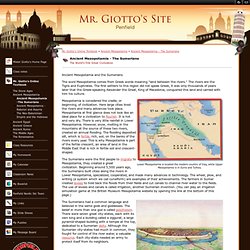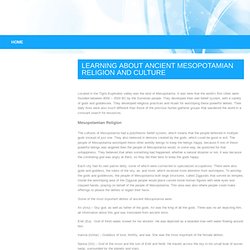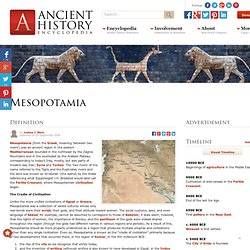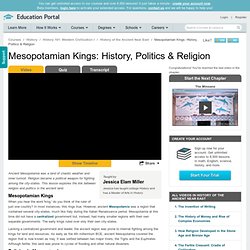

Cuneiform: 6 things you (probably) didn’t know about the world’s oldest writing system. Distinguished by its wedge-shaped marks on clay tablets, cuneiform script is the oldest form of writing in the world, first appearing even earlier than Egyptian hieroglyphics Tuesday 26th May 2015 Submitted by: Emma Mason A counting of goats and rams in cuneiform script, ancient Ngirsu, Iraq, 2360 BC.

(DEA / G. DAGLI ORTI/De Agostini/Getty Images) Ancient Mesopotamia - The Sumerians. Ancient Mesopotamia and the Sumerians The word Mesopotamia comes from Greek words meaning "land between the rivers.

" The rivers are the Tigris and Euphrates. The first settlers to this region did not speak Greek, it was only thousands of years later that the Greek-speaking Alexander the Great, King of Macedonia, conquered this land and carried with him his culture. Early Dynastic Period And Hammurabi. History - Ancient History in depth: Mesopotamia. HISTORY OF MESOPOTAMIA. The conqueror of Ur is a usurper, which is no doubt why he adopts the name Sargon - meaning the 'true king'.

He is Semitic in origin, and tradition states that he begins life as a fruit grower. He gradually conquers the Sumerian cities - first Kish, then Uruk, then Ur - before founding a capital city of his own, Akkad. Learning about Ancient Mesopotamian Religion and Culture. Located in the Tigris-Euphrates valley was the land of Mesopotamia.

It was here that the world’s first cities were founded between 4000 – 3500 BC by the Sumerian people. They developed their own belief system, with a variety of gods and goddesses. They developed religious practices and rituals for worshiping these powerful deities. Their daily lives were also much different than those of the previous hunter-gatherer groups that wandered the world in a constant search for resources. Lecture 2: Ancient Western Asia and the Civilization of Mesopotamia. What is good in a man's sight is evil for a god, What is evil to a man's mind is good for his god.

Who can comprehend the counsel of the gods in heaven? The plan of a god is deep waters, who can fathom of it? Where has befuddled mankind ever learned what is a god's conduct? Before Civilization Between 9000 B.C. and the beginning of the Christian era, western civilization came into being in Egypt and in what historians call Ancient Western Asia (modern-day Cyprus, Syria, Lebanon, Israel, Jordan, Turkey, southwestern Russia, Iraq and Iran).
The earliest permanent settlements occurred between 9000-6000 B.C. and were accompanied by the domestication of plants and animals. Around 10,000 B.C., many hunter-gatherers living along the coastal plains of modern Syria and Israel and in the valleys and hills near the Zagros Mountains between Iran and Iraq began to develop special strategies that led to a transformation in the human community. What you have ordered comes true! What has he planned? Mathematics in Ancient Iraq: A Social History. Mathematics in Ancient Iraq: A Social History Availablity Usually ships in 24 hours Publisher : Princeton University Press This monumental book traces the origins and development of mathematics in the ancient Middle East, from its earliest beginnings in the fourth millennium BCE to the end of indigenous intellectual culture in the second century BCE when cuneiform writing was gradually abandoned.

Eleanor Robson offers a history like no other, examining ancient mathematics within its broader social, political, economic, and religious contexts, and showing that mathematics was not just an abstract discipline for elites but a key component in ordering society and understanding the world. The region of modern-day Iraq is uniquely rich in evidence for ancient mathematics because its prehistoric inhabitants wrote on clay tablets, many hundreds of thousands of which have been archaeologically excavated, deciphered, and translated.
MEDICINE IN ANCIENT MESOPOTAMIA. Mesopotamia. Mesopotamia (from the Greek, meaning 'between two rivers’) was an ancient region in the eastern Mediterranean bounded in the northeast by the Zagros Mountains and in the southeast by the Arabian Plateau, corresponding to today’s Iraq, mostly, but also parts of modern-day Iran, Syria and Turkey.

The 'two rivers' of the name referred to the Tigris and the Euphrates rivers and the land was known as 'Al-Jazirah '(the island) by the Arabs referencing what Egyptologist J.H. Breasted would later call the Fertile Crescent, where Mesopotamian civilization began. Mesopotamia - The British Museum. Mesopotamia and the Fertile Crescent. Before they settled down in various parts of the world, humans lived as nomads for tens of thousands of years.

Nomads are people who have no permanent home and travel in search of food and safety. A typical nomadic group might include an extended family of about ten adults and their children. They would temporarily camp in an area for a few weeks or months -- the men hunting animals and the women gathering fruit, grains, seeds and nuts. When the nomads exhausted the resources in that area they moved on. advertisement. Mesopotamia and the Fertile Crescent. Mesopotamia, A History of. A Place For Civilization To Begin. Mesopotamia Edited By: Robert Guisepi.

Mesopotamia: Crash Course World History #3. Mesopotamian Kings: History, Politics & Religion - Western Civilization I Video. Mesopotamian Kings When you hear the word 'king,' do you think of the ruler of just one country?

In most instances, this rings true. However, ancient Mesopotamia was a region that contained several city-states, much like Italy during the Italian Renaissance period. Mesopotamia at this time did not have a centralized government but, instead, had many smaller regions with their own separate governments. The early kings ruled over only their own city-states. Mesopotamian Religion. Mesopotamian Religion. By Eugene Webb, University of Washington The religions of the ancient world in the Near East and Mediterranean regions developed according to an inner logic of questioning growing out of the historical experience of peoples who were in more or less continuous interaction through commerce, warfare, colonization, and so on, over a period of some three thousand years. These included the ancient Sumerians and their successors in the Tigris-Euphrates valley, the Egyptians, the Canaanites, Phoenicians, and Israelites, the Persians, and the Greeks and Romans.
In the course of their histories each of these peoples had to work out interpretations of the relations between human beings and the universe, between the individual and society, and between cosmic, social, and personal order. They also had to develop a self-interpretation of man as a being who combines longings for truth and ideal values with an awareness of his own tendency to violate the ideals he conceives. MESOPOTAMIAN RELIGION by british british on Prezi. The Ancient World. Driving north out of Samawa towards Baghdad, a short way beyond the Euphrates bridge, a tarmac track leaves the main road, heading eastwards into a scarred, dun-coloured wasteland. Soon you enter the real desert, swept by sandstorms. Then, after 60km or so, a haunting scene unfolds. The Cuneiform Writing System in Ancient Mesopotamia: Emergence and Evolution.
Activity 1. World History Lesson 1- Mesopotamia. Science and Technology in Mesopotamia (Mathematics, Astronomy and Astrology, and Medicine) Mesopotamians are probably best known for invention of writing but their achievements in science and technology correspond to the level of socioeconomic development and are comparable with achievements of modern society. Harsh weather and environmental conditions required artificial irrigation, while construction of irrigation systems and building activities greatly influenced the development of mathematics.
On the other hand annual inundations and agricultural activities resulted in the development of calendar which based on observation and study of the stars, moon and the sky. Irrigation systems were essential for Mesopotamian agriculture and required collaboration of a wider community, good organization and a single plan which eventually led to the formation of centralized government. Gale - Enter Product Login. Religion of Mesopotamia. Fast Facts About Mesopotamia | Mesopotamian Religion We can only speculate about early religion. Mesopotamia. Collapse: Mesopotamia. Ancient Mesopotamia. Ancient Mesopotamia. Mesopotamia: Sailboats, Wheels, Cuneiform Writing. Mesopotamia - LookLex Encyclopaedia. History - Ancient History in depth: Mesopotamia. Religion in Ancient Mesopotamia. Mesopotamia through Shakespeare. Early Dynastic Mesopotamia. Around 2900 BC, after the flood, comes a time period called Early Dynastic, which lasts for about 600 years (there is a good deal of disagreement).
The Money of Ancient Mesopotamia. Money is used to exchange goods. If you have something I want, I can offer you money or gold or whatever for it. The Cuneiform Writing System in Ancient Mesopotamia: Emergence and Evolution. Activity 1. Encyclopedia Britannica. HISTORY OF MESOPOTAMIA.